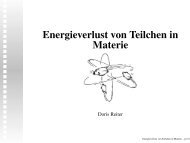The FEE Server Control Engine of the ALICE-TRD - Westfälische ...
The FEE Server Control Engine of the ALICE-TRD - Westfälische ...
The FEE Server Control Engine of the ALICE-TRD - Westfälische ...
You also want an ePaper? Increase the reach of your titles
YUMPU automatically turns print PDFs into web optimized ePapers that Google loves.
4 <strong>The</strong> <strong>ALICE</strong> Transition Radiation Detector<br />
<strong>the</strong> hardware on it. It contains <strong>the</strong> ROC type, <strong>the</strong> serial number <strong>of</strong> <strong>the</strong> ROC and two<br />
structs with information about <strong>the</strong> ROBs and <strong>the</strong> ORIs on <strong>the</strong> ROC.<br />
Most <strong>of</strong> <strong>the</strong> sections have one or more variables to store checksums. <strong>The</strong> checksums<br />
can be used to ensure that no bits have flipped during <strong>the</strong> transfer from <strong>the</strong> Command<br />
Coder to <strong>the</strong> <strong>FEE</strong><strong>Server</strong>. Up to now <strong>the</strong> checksums are nei<strong>the</strong>r created nor checked. <strong>The</strong><br />
functionalities are not implemented yet.<br />
One task <strong>of</strong> <strong>the</strong> InterComLayer is to compose and send <strong>the</strong> configuration. But <strong>the</strong> ICL<br />
has a second task. Each <strong>FEE</strong><strong>Server</strong> publishes 10 DIM data channels: 1 message channel,<br />
1 acknowledge channel, 1 channel containing <strong>the</strong> <strong>FEE</strong><strong>Server</strong> FSM status, 1 channel for<br />
<strong>the</strong> DCS board temperature, and 6 channels for voltage sensor readings (see section 4.2).<br />
In total, <strong>the</strong> <strong>TRD</strong> has 540 <strong>FEE</strong><strong>Server</strong>s running. It turned out that PVSS can handle a<br />
maximum <strong>of</strong> 1000 changes in <strong>the</strong> DIM data channels per second. O<strong>the</strong>rwise it may crash.<br />
<strong>The</strong> ICL connects to all DIM channels <strong>of</strong> <strong>the</strong> <strong>FEE</strong><strong>Server</strong>s and re-publishes <strong>the</strong> channels.<br />
Before re-publishing, it merges all message channels to one channel and suppresses <strong>the</strong><br />
voltage sensor channels <strong>of</strong> <strong>the</strong> DCS boards which have no sensing wires to <strong>the</strong> power<br />
bus bars (see section 4.2). <strong>The</strong> acknowledge channels are handled by <strong>the</strong> ICL and not<br />
re-published. <strong>The</strong> ICL takes care that in <strong>the</strong> re-published DIM channels <strong>the</strong> maximum<br />
update rate PVSS can handle is not exceeded. <strong>The</strong>refore <strong>the</strong> PVSS program connects<br />
only to <strong>the</strong> republished channels even if <strong>the</strong> original channels <strong>of</strong> <strong>the</strong> <strong>FEE</strong><strong>Server</strong>s are still<br />
available.<br />
Additional monitoring s<strong>of</strong>tware can ei<strong>the</strong>r connect to <strong>the</strong> republished DIM channels or<br />
to <strong>the</strong> channels provided by <strong>the</strong> <strong>FEE</strong><strong>Server</strong>s. Figure 4.18 shows two examples. A database<br />
which logs all messages from <strong>the</strong> <strong>FEE</strong><strong>Server</strong>s connects to <strong>the</strong> merged message channel <strong>of</strong><br />
<strong>the</strong> ICL whereas a program monitoring <strong>the</strong> acknowledge channels has to connect directly<br />
to <strong>the</strong> <strong>FEE</strong><strong>Server</strong>s.<br />
47







